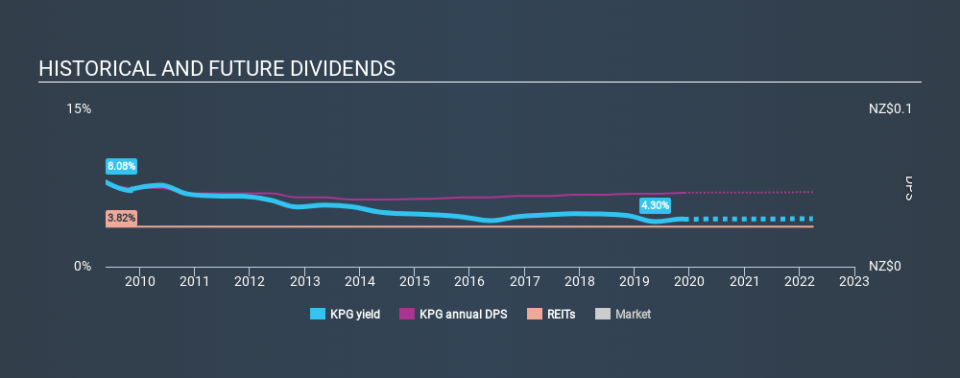Why You Should Leave Kiwi Property Group Limited (NZSE:KPG)'s Upcoming Dividend On The Shelf

Some investors rely on dividends for growing their wealth, and if you're one of those dividend sleuths, you might be intrigued to know that Kiwi Property Group Limited (NZSE:KPG) is about to go ex-dividend in just 4 days. You will need to purchase shares before the 2nd of December to receive the dividend, which will be paid on the 18th of December.
Kiwi Property Group's next dividend payment will be NZ$0.12 per share, which looks like a nice increase on last year, when the company distributed a total of NZ$0.07 to shareholders. Dividends are a major contributor to investment returns for long term holders, but only if the dividend continues to be paid. We need to see whether the dividend is covered by earnings and if it's growing.
See our latest analysis for Kiwi Property Group
Dividends are usually paid out of company profits, so if a company pays out more than it earned then its dividend is usually at greater risk of being cut. Kiwi Property Group is paying out an acceptable 72% of its profit, a common payout level among most companies. That said, REITs are often required by law to distribute all of their earnings, and it's not unusual to see a REIT with a payout ratio around 100%. We wouldn't read too much into this. Yet cash flows are even more important than profits for assessing a dividend, so we need to see if the company generated enough cash to pay its distribution. It paid out more than half (74%) of its free cash flow in the past year, which is within an average range for most companies.
It's encouraging to see that the dividend is covered by both profit and cash flow. This generally suggests the dividend is sustainable, as long as earnings don't drop precipitously.
Click here to see the company's payout ratio, plus analyst estimates of its future dividends.
Have Earnings And Dividends Been Growing?
Businesses with shrinking earnings are tricky from a dividend perspective. If earnings fall far enough, the company could be forced to cut its dividend. So we're not too excited that Kiwi Property Group's earnings are down 2.6% a year over the past five years.
Another key way to measure a company's dividend prospects is by measuring its historical rate of dividend growth. Kiwi Property Group has seen its dividend decline 1.3% per annum on average over the past ten years, which is not great to see.
Final Takeaway
Is Kiwi Property Group an attractive dividend stock, or better left on the shelf? While earnings per share are shrinking, it's encouraging to see that at least Kiwi Property Group's dividend appears sustainable, with earnings and cashflow payout ratios that are within reasonable bounds. With the way things are shaping up from a dividend perspective, we'd be inclined to steer clear of Kiwi Property Group.
Ever wonder what the future holds for Kiwi Property Group? See what the seven analysts we track are forecasting, with this visualisation of its historical and future estimated earnings and cash flow
If you're in the market for dividend stocks, we recommend checking our list of top dividend stocks with a greater than 2% yield and an upcoming dividend.
If you spot an error that warrants correction, please contact the editor at editorial-team@simplywallst.com. This article by Simply Wall St is general in nature. It does not constitute a recommendation to buy or sell any stock, and does not take account of your objectives, or your financial situation. Simply Wall St has no position in the stocks mentioned.
We aim to bring you long-term focused research analysis driven by fundamental data. Note that our analysis may not factor in the latest price-sensitive company announcements or qualitative material. Thank you for reading.

 Yahoo Finance
Yahoo Finance 
